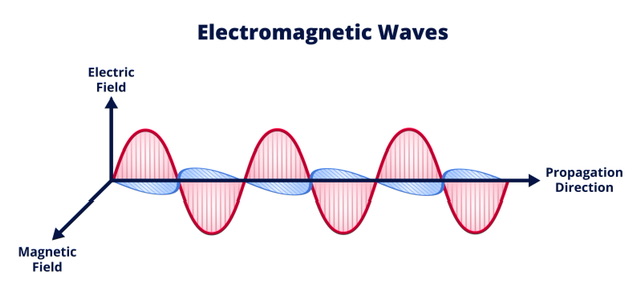We'll be back in a bit !
The system is currently undergoing a routine upgrade to ensure you get the best learning experience. The maintenance is expected to continue till 8:00 pm. Please check back later.
Thank you for your understanding!

A wave is a phenomenon that transfers energy and momentum between points without any medium change. Waves are observed in various forms like ocean waves and electromagnetic waves, sound waves, etc. and they find applications in our day-to-day activities that range from communication to laser surgery, to music.
Common examples of waves include light waves, which allow us to see the world around us and sound waves that facilitate hearing. Another example of a wave are the ripples created when a stone is dropped on the surface of a water body. These ripples emanate from the point of impact and travel outwards.
Deflection on the surface of the water
Electromagnetic waves consist of continuously oscillating electric and magnetic fields and thus, can travel without a medium at the speed of light. Our understanding of electromagnetic waves comes from the theories posited by James Clark Maxwell, whose equations form the foundations of electrodynamics. His theory allowed us to understand light as an electromagnetic wave travelling at a speed of 3108ms-1.
Today, the knowledge of electromagnetic waves has revolutionized our lives. Mobile phones communicate via radio waves, just like televisions. X-rays are also light waves and a microwave oven uses light waves as well. It just so happens that these forms of light waves aren’t visible to the naked eye. Thus, the applications of electromagnetic waves are innumerable in our lives, even if a lot of them are invisible.
X-ray image of the human body
Electromagnetic waves are generated by oscillating charged particles.
Unlike mechanical waves, EM waves do not require a medium to travel.
They travel at the speed of light.
EM waves are composed of electric and magnetic fields continuously varying in time.
These waves can undergo the phenomenon of diffraction and interference and have a definite polarisation.
Electromagnetic waves carry energy and momentum on their own.
Consider an object that can absorb electromagnetic waves. When an atom of such a material is hit by an electromagnetic wave, it absorbs the wave and its electrons start vibrating. The oscillation of this vibrating electron creates further electromagnetic waves and thus, EM waves can propagate through objects.
Our entire knowledge of electrodynamics can be summarized in just five equations, four of which were given by Maxwell. They were derived from previous known relations with slight modifications and we list them here:
Gauss’ law, which relates electric fields with charge.
Non-existence of magnetic monopoles, evidenced by the following relation:
Faraday’s law, relates a time-varying magnetic field with an electric field.
Ampere-Maxwell law, derived by Maxwell with slight modification into Ampere’s law.
These equations showcase the wave nature of light and describe how electric and magnetic fields are closely related in electromagnetic waves.
A charged particle at rest produces an electric field only. However, when the charged particle is in motion, it constitutes a current and we know that a current-carrying conductor gives rise to magnetic fields. Now, imagine if a charge was moving with a particular acceleration. In such a case, it would create electric and magnetic fields that would be correlated and thus, give rise to electromagnetic waves.
Another way for EM waves to be created is via oscillating charges. When an electron is oscillating about a center, it is constantly experiencing acceleration and thus, it produces electromagnetic waves of a particular frequency.
The frequency of the EM wave is related to the frequency of the variation of its electric and magnetic fields, which vary sinusoidally with time and space. Its energy is also related to the frequency via the relation E=hv, where h is Planck’s constant.
Electromagnetic waves are transverse in nature. This means that the oscillations of electric and magnetic fields that comprise EM waves are perpendicular to the direction of propagation. Interestingly, the electric and magnetic fields are themselves mutually perpendicular, and hence, if the wave was traveling along the Z-axis, and the electric field oscillations were in the X direction, the magnetic field would be in the Y direction. This was experimentally proved by Hertz’s experiment.
Electromagnetic waves are made up of continuously varying electric and magnetic fields and they travel at the speed of light. They are created via oscillating or accelerating charges and carry energy and momentum of their own. Our knowledge of electrodynamics is summarised in Maxwell’s equations, which showed how the light was an EM wave. The transverse nature of EM waves was proven experimentally by Hertz’s experiment.
1. What are the uses of an electromagnet?
Electromagnets have revolutionized our lives. Medical sciences make use of them in the form of MRI scans, industries use them for separating magnetic materials, and they are also used in detecting metals at airports and security checkpoints.
2. What are infrared rays?
Infrared waves are also light waves, but their frequency is lower than that of the red color, which prevents us from being able to see them with the naked eye.
The electromagnetic spectrum is the range of frequencies that electromagnetic radiation or in other words, light can have. With the naked eye, we can only see a very small portion of this spectrum.
UV rays carry high energy and thus, can be used to kill bacteria or remove pathogens, detect fingerprints, and even determine molecular structure.
5. Explain about microwave oven
Microwaves have frequencies that closely match the frequency of water molecules and thus, they heat up the water content in our foods.
